All About Korean Rice
Learn all about the variety of Korean rice including white rice, sweet white rice, brown rice, wild rice, black rice, and mixed grain rice.
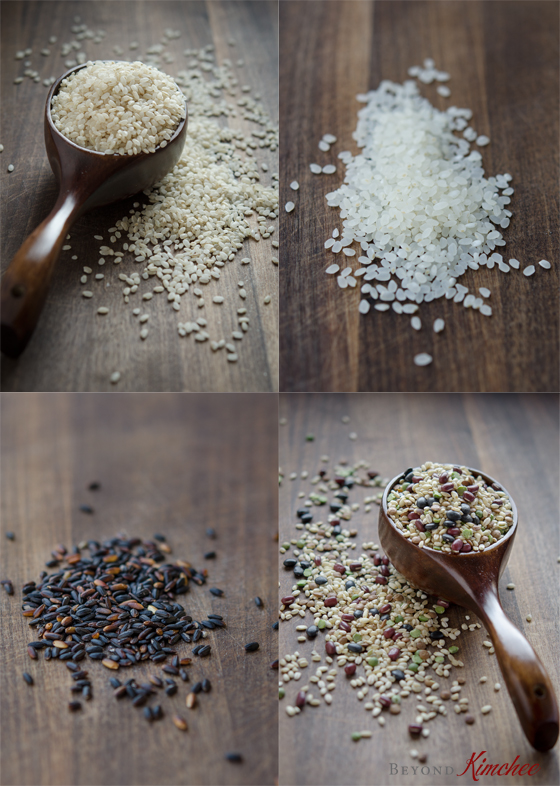
Rice means more than its purpose as a staple food in Korean Cuisine. It is a symbol of life and representation of prosperity. There are many different variety of Korean rice that are popular in Korean cuisines.
For thousands of years in the past, one’s wealth in Korea was determined by how much of rice had been stored in one’s food storage.
Having four very distinct seasons with a long period of cold winter, and steep mountains covering 70% of its land, Korea is a difficult place to grow rice. Those seasonal and geographical challenges and limitations, however, have made Koreans to work diligently and effectively in time management to grow rice.
Throughout their history, Koreans have disciplined themselves with one life principle: if you don’t work diligently in the rice field during the spring and summer time, the fall harvest will be affected, and you will not have enough rice to sustain life through the long winter.
Rice translates into “Ssal (쌀)” in Korean. But once cooked, it will have a completely new name; “Bap (밥)”. The word “Bap” means more than just cooked rice. It is an emotion-filled word that recollects one’s childhood and life in general.
Bap also has a meaning of a “meal” and it often becomes a tool for socializing. For example, a person extends an invitation to friends or acquaintances by asking them if he can treat the person with Bap–meaning an entire meal and time spent together.
Koreans do not just eat one kind of rice. There are several types. I hope this post will help you understand the different varieties of Korean rice so that you can adopt them in your diet.
Different Kinds of Korean Rice
#1: Short Grain White Rice (백미, bakmi)
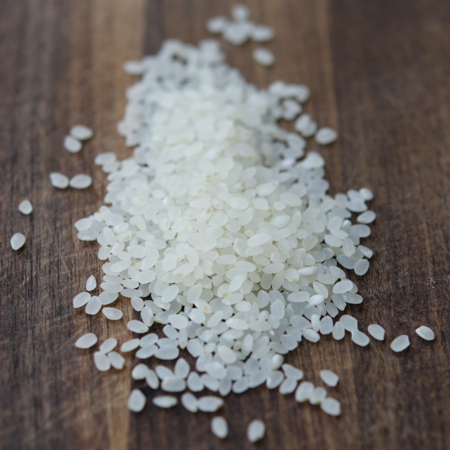
Short grain white rice wins the best taste award but has the worst nutritional value. It is completely milled, which means its husk, bran and germ is removed during the milling process leaving just the starch.
Despite the excessive milling process, white rice still contains some B-vitamins. Unfortunately B-vitamins are water soluble, so they can be easily washed out in during rinsing and cooking.
You can easily cook white rice in a rice cooker but to enjoy the best flavor, try cooking it over the stove: How to cook rice on the stove. Use this white rice to make the popular kimbap (Korean rice roll).
#2: Short Grain Brown Rice (현미, hyunmi)
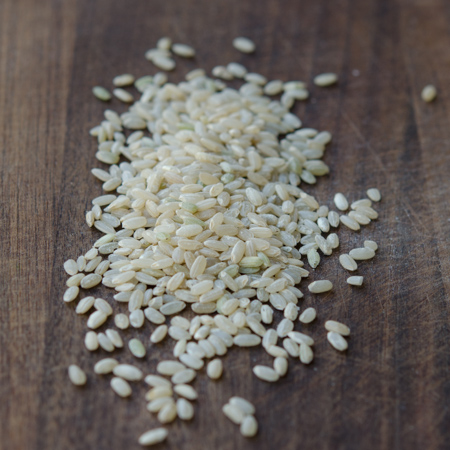
Unlike white rice, brown rice has the bran and germ still attached. Some brown rice even still has its husk. Brown rice has a higher nutritional value than white rice, with many vitamins and fiber.
It takes longer to cook and longer to digest, and it takes some time to get used to the taste. Many Koreans combine white rice and brown rice together to bring better texture and taste.
#3: Half Milled Brown Rice (5분도미, 5 bundomi)
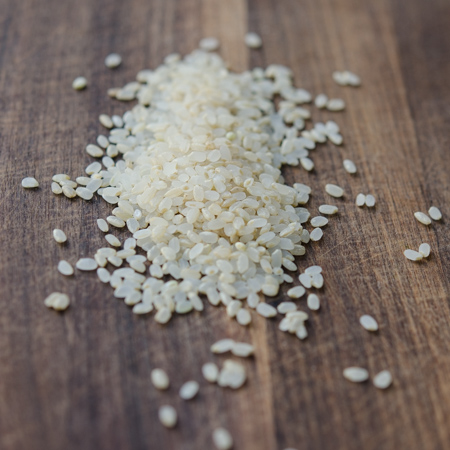
Half milled brown rice is in between white rice and brown rice. It has gone through a milling process but some portion of the bran and germ remain intact in the rice. Half milled brown rice is my personal choice if I have to choose the best rice, balancing taste and nutritional.
A similar type of rice, called Germinating Brown Rice (발아현미, Bal-a hyunmi), is unpolished brown rice with the germination in process, which brings a softer texture than brown rice and better flavor. Germinating Brown Rice is another popular type of rice in Korea, but it is expensive.
#4: Short Grain Sweet Rice or Glutinous Short Grain Rice (찹쌀, chapssal)
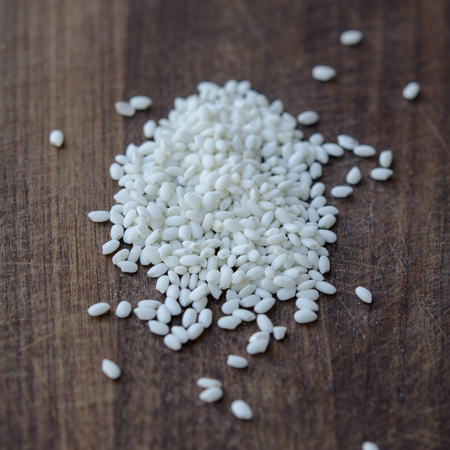
Short grain sweet rice is the “stickiest” variety of rice consumed in Korea. It is widely used in making rice cakes and dessert.
The glycemic index of this rice is very high. If you have high blood sugar, you should not consume too much of this rice. I personally like to steam this rice in a steamer to enjoy the chewy texture.
Some packaged Korean short grain white rice has a little bit of sweet rice mixed in to increase its stickiness.
#5: Wild Short Grain Rice (야생찹쌀, yasaeng chapssal)
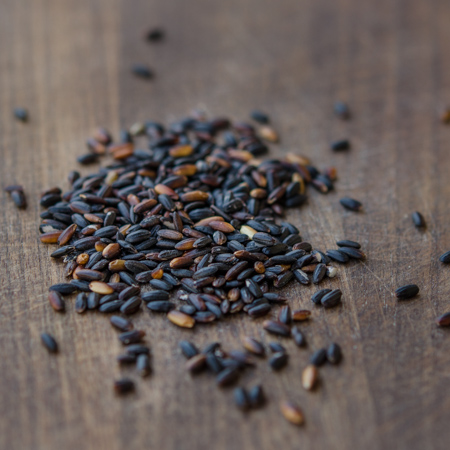
Also known as black Japonica rice, this particular rice is combination of two types of rice grown in the same field; black short grain rice and brown rice. Interestingly, it was created in California from Japanese seeds. When cooked, it has a sweet and nutty flavor. Koreans usually mix it with white rice.
#6: Black Rice (흑미, heukmi)
Originally harvested in ancient China, black rice has a nick name of “forbidden rice” because it was reserved for emperors only. Black rice has a fragrant nutty taste so it can go with many types of cuisines in both savory and sweet. It is chock full of fiber and iron.
#7: Mixed Grain Rice or Multi-Grain Rice (잡곡, japgok)
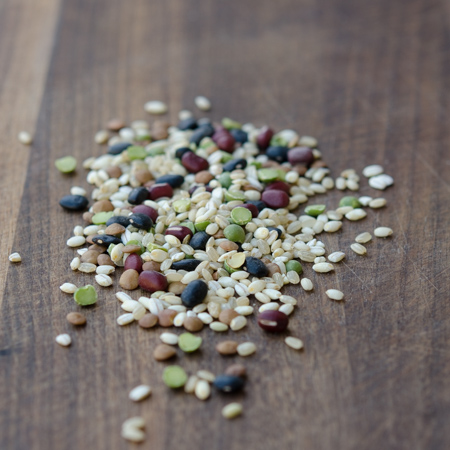
Mixed grain rice is basically what it says. It is mixed with other types of grains and legumes. It comes in many varieties depending on the the kinds and the numbers of grains added. Barley, oat, millet, sorghum, lentil, and a variety of beans and peas are the most common ingredients found in a packet of mixed (multi) grain rice.
It is essential to soak mixed grain rice prior to cooking in order for it to cook evenly. You can learn how to prepare and cook mixed grain rice in this post: Multi-grain rice-jabgok bap
Rice is the most widely consumed grain in the world. It is a staple food in Asian diets and is enjoyed by billions of people everyday.
My mother always scolded me if I wasted grains of rice when I rinsed the dishes, or left grains of rice in my rice bowl. She lectured us with the same words everyday: “A single grain of rice is like a drop of a farmer’s tears and sweat. So do not waste it, rather appreciate someone’s hard work in the field.”
Well, I wish I can lecture that to my smart-aleck kids. They will insist on eating their dessert cakes and cookies so that they can finish the entire plate to show their support of wheat and sugar cane farmers.
Enjoy your rice! It is indeed the fruit of someone’s hard labor.
The Right Equipment To Cook Korean Rice
Cooking rice on the stove (good for white rices)
I use a 3 1/2-quart round Dutch oven(up to 8 servings) if I have to feed many people.
For a smaller portion I use 1 1/2-quart French oven(up to 4 servings) for my rice. They are enameled cast iron pot with a heavy lid, it keeps the moisture inside and brings the fantastic result.
If you want to cook brown rice or mixed grain rice, you will need to soak the rice for at least 4 hours or overnight so that the rice grains will absorb the moisture prior in cooking. Without pre-soaking, it is difficult to get soft texture on the stove top cooking or even regular rice cooker.
Electric Pressure Rice Cooker
Cooking rice can’t be more convenient than using a rice cooker. If you want to cook brown rice, wild rice, or multi-grain rice, try a Pressure Rice Cooker. The pressure in the cooking method will make the harsh grain rice into soft yet chewy, flavorful rice like no other.
With a touch of button, without worrying about timing or boiling over on the stove, you will have a popping hot delicious rice ready fairly quickly. Also try cooking Jasmin rice in a pressure rice cooker, too. It will have a texture of short grain rice. Delicious!

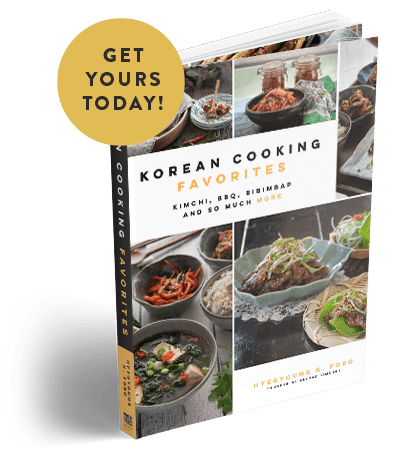
Hi
I am a huge fan of Korean food! Your recipes are so unique and mouthwatering!
I have a quick question for you.
I bought wild sweet rice at a Korean grocery shop. The package has all in Korean. The letters look the same as #5 Wild short grain rice 야생찹쌀, YASAENG CHAPSSAL here.
However, mine is long grain. How do I cook it in a rice cooker or a pot?
Yasaeng chapssal is commonly mixed with white short-grain rice and other grains to create multigrain rice (https://www.beyondkimchee.com/multi-grain-rice-japgok-bap/). This wild rice is indeed a hard grain, and pressure cooking is an efficient and convenient method for preparing it. Soaking the rice for 3-6 hours beforehand is essential to soften it. After soaking, it can be cooked in a rice cooker using the brown rice setting or on the stovetop. When cooking on the stovetop, ensure to use plenty of water (1:1.5 soaked rice to water ratio) and allow for extended simmering time until the grains are soft enough. Hope this helps. Thanks!
Great!
I will try your instruction. Thank you for your quick response!
Hello,
I am watching Pachinko on Apple, and rice is prominently featured so I did a Google search and found your website. Thank you for all the information. In the show they can tell that the rice came from Korea, does it taste really different from other rice. I don’t know if you have seen it, but it looked to me that they are talking about rice number one.
I dream to go to Korea one day, I am in love with the country and it’s culture
Kindest regards
Hi Philippe
Thanks for your comment. Yes, I am also watching Pachinko. I became emotional, too, at the scene of Sunja’s mother washing and cooking the rice to feed her daughter. My childhood memory of how my mother valued the rice to feed her 5 children came upon me.
Even though I came to U.S. over 30 years ago and having been eating short grain white rice grown in California all these years, I still remember the taste of Korean rice that my mother prepared by a traditional method. She cooked in an iron or stone pot on the stove. In some degree, traditional Korean rice has more flavor than other white short grain rice grown in different countries. They are chewier, and have a subtle sheen once cooked. The aroma is different, too.
Unfortunately, Japanese rice grain has influenced Korean rice farming since the Japanese occupation. Korean farmers were forced to plant Japanese rice seeds, and much of authentic Korean rice crops have lost its place until recent decades. Korean rice grown with Japanese rice seeds are cheaper and widely available throughout Korea. However, you will be able to find Korean rice grown with original Korean rice seeds easily. It’s more expensive but worth the price.
If you visit Korea, the best place to taste authentic Korean rice is by dinning at upscale “Han Jungshik (한정식)” style restaurants in Gyeonggi province, south or Seoul. That province is prominent for their rice farming and even local Koreans visit there often to enjoy the pure Korean rice.
I hope you will get a chance to visit Korea someday soon and enjoy the food, culture, and friendly people there.
Hello there. When I saw Philip’s question to you, I had to join the conversation, because I came here for the same reason. I too, saw Pachinko (twice becasue the past and present were a little confusing to me, but when I saw it the second time, I understood it much better). I wanted to know what was it about the Korean rice that was very special, and I thank you for your explanations here. Where I live, there is a large Asian population, with the majority being Korean from I have experienced. I loved the film, and have much empathy for what your people went through at the time. And being that I have many Asian supermarkets here, I will be sure to pick up some of the rice I see here. The Black rice I have seen, and the short grain ones as well. I will try them and see which I like best. Thanks again.
Hello, thanks for your precious explanations. I have a Cuckoo CRP-P1009S and I’m wondering if I want to cook wild rice should I use brown rice, glutinous rice or mixed rice program which is the most suitable ? Thanks a lot for your help and wish you a great day.
Hi Ingrid
I would use either brown rice or mixed grain rice setting. I would recommend soaking your wild rice for at least 30 minutes before using the cooker. That will help soften the texture a lot better. Hoepe this helps. Thanks.
Hi Holly, just stumbled across this trying to learn about rice I just bought.
I have black (japonica) rice already, and recently bought wild sweet rice at a Korean store, but I think it looks very similar to black rice except the grains are longer and some are brownish (but cooks up all black for the most part). Is this as healthy as black (“forbidden”) rice? It tastes very nice (I add seasonings to my water when cooking), but if it isn’t as healthy I’ll stick with the black rice.
Thank you so much in advance!
Barbara
Hi Barbara
Yes, the wild sweet rice has a good nutritional value. It is cross between black rice and brown rice in the sweet rice form. It has similar texture and taste to the black rice. I like to add the wild sweet rice with white rice. Very well balanced and tastes great, too.
This is too much. Stop trying to make it seem like your culture/food is special. You guys eat peasant food. Your rice isn’t special, it’s just cheap.
Oberie, you must have had a very bad day, haven’t you?
Your comment is very arrogant and ignorant. Evey country has their own unique culture that can not be measured that one is better than the other. However each culture has its special value regardless. Food is one representation of its culture.
We all eat peasant food whether it is rice or wheat. Is there something wrong with it?
By the way, some of the rice I posted above? Actually it is not that cheap, just to let you know. In fact, I don’t think you even have any basic knowledge about grains around the world. Go research more, get yourself educated, and comeback if you want a further argument.
Oberle, you are so rude. If you don’t have anything nice to say just don’t say it.
Every culture has its own uniqueness and that makes the world a more interesting place.
I am not Korean and I find this article very informative.
Oberle–
How rude of you to say that. Korean rice is indeed expensive. It is not cheap at all. But more surprising is your simple narrow-mindedness and lack of manners which obviously you weren’t taught when you were young. Shame on you.
I have a recipe for mix rice. It says to use Mepssal – short grain rice, and I was told that this is just “normal” typical korean rice. But when I tried to find it at smaller markets (Home plus in Seoul), they told me it is not “normal” and to look at bigger supermarkets. Please, could you make it clear, so I can understand better?
Thanks, Jana
Hi Jana
The mapssal is the normal everyday white short grain rice that Koreans eat. I think the salesperson at Home plus misunderstood. Basically all the rice you can find in the Korean supermarket are the mapssal (or just plain “Ssal (쌀)”). The “chapssal(찹쌀)” is the sweet sticky short grain rice, aka glutenous short grain rice.
You can also tell the difference between the two rices by the clarity of their grains. The mapssal grains are more translucent and the chapssal grains are opaque and whiter in color.
Hope this helps.
If you’re combining white and brown rice as suggested, would you do that before it’s cooked, or mix the two kinds of rice after cooking each separately?
Hi Eileen
You can cook both rices together. You will need to soak the brown rice in water for at least 1 hr before adding the white rice, though, so that they can cook evenly.
Holly, I enjoyed reading this post so much and felt an emotional attachment as you told your story. In Chinese, uncooked rice is ‘mai’ and cooked rice is ‘fan’ and also symbolises a meal, so naturally I understood what you meant.
Did you ever try purple rice when you were living in HK? 🙂
lucylovestoeat.com
Hi Lucy, I think there are a lot of cultural and even social similarity among far east Asian countries. Rice means more than a kind of grain that fills up our stomach. I know the word “fan” because I liked every dishes in HK or China that has the sound of “fan”. Great to hear from you as always!
Dear Holly,
thank you for this article. In Europe we don’t have such a deep culture and variety of rice. Very interesting, 감사합니다!
Hi there, love this rice post! Can you reccomend a good korean rice cooker? I’m interested in the pressure rice cooker. Thanks!!
thanks for sharing. i learnt something from your article